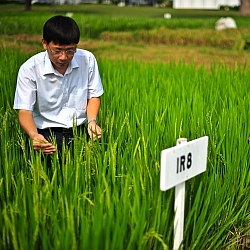 A partnership between the Chinese Academy of Agricultural Sciences and the International Rice Research Institute (IRRI) is developing new varieties of rice designed to grow under tough conditions by the poorest farmers. The early results of the project are reported in the January issue of the magazine Rice Today, published by IRRI.
A partnership between the Chinese Academy of Agricultural Sciences and the International Rice Research Institute (IRRI) is developing new varieties of rice designed to grow under tough conditions by the poorest farmers. The early results of the project are reported in the January issue of the magazine Rice Today, published by IRRI.
Green Super Rice (GSR), as the new type is called, is actually a mix of more than 250 different potential rice varieties and hybrids adapted to growing conditions such as drought and low inputs, including no pesticide and less fertilizer. The new rice is also designed to quickly establish itself, to out-compete weeds for surrounding nutrients, thus reducing the need for herbicides.
Earlier varieties of rice, including many of those planted today that generate superior yields, require optimal conditions to return high yields. For example, IR64, a popular rice variety developed at IRRI in 1985, generates a high yield, but is significantly affected by drought. The GSR technology develops rice plants that are drought-tolerant but still have the desirable output traits of IR64.
That technology is based on genetics. IRRI says GSR researchers subjected a large number of back-crossed second-generation breeding lines and succeeding generations to biotic stresses, such as insects and fungi, and abiotic stresses, such as intense sunlight or drought. By exposing rice varieties to these stresses, the researchers could eliminate weaker lines and identify stronger lines that exceed the performance range of their parents under these extreme conditions.
The GSR technology employs a much larger base of parent rice varieties than before. Adapting the model of China’s National Rice Molecular Breeding Network, GSR uses 46 recurrent parents, whereas earlier efforts used just three parent varieties. Researchers drew from 500 donor varieties, which gave them a larger pool of available genes. Each of these genes has in turn been submitted for complete genome re-sequencing, to further strengthen the project’s molecular breeding capabilities.
The next step, already underway according to IRRI, is to put Green Super Rice in the hands of national agricultural agencies in rice-growing countries for testing and development.
Read more: NGOs: Technique Boosts Rice Production with Less Water
Photo: IRRI/Flickr
* * *

 RSS - Posts
RSS - Posts
[…] This post was mentioned on Twitter by Alltop Science. Alltop Science said: Research Collaboration Developing More Robust Rice http://bit.ly/eLqPRO Science.alltop […]
[…] Read more: Research Collaboration Developing More Robust Rice […]
[…] Read more: Research Collaboration Developing More Robust Rice […]